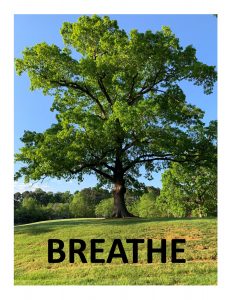Have you ever thought of breathing as a type of movement or physical activity? Consider this. It’s the first movement we did when we were born. And we all do it – an average of 14-16 times per minute. It’s essential for every other aspect of living. And it’s accessible to everyone. Most of the time it’s involuntarily. It sets a rhythm for our lives, and it sets the tone and frequency for the rest of our body to follow. It’s like a game of follow the leader (I loved that game – especially when I was the leader 😊). Our breath guides our lives. Can’t live without it! I take it for granted most of the time. And, like many other types of movement, with awareness and intentional practice, breathing offers us the power to enhance our quality of life.
SIMPLY BREATHE - AWARENESS
I know that sounds weird. Just stay with me. Yes, I said, simply breathe. A breath practice can simply start with noticing breath…just like it is. How does it feel on the inhale and the exhale? Just sense it as it moves in and out. Experiment with slowing down the breath and matching the pace of the inhale and exhale. Slowing our breath down and lengthening the exhale invites the parasympathetic channels to take over the body. That means slowing down our heart rate and signaling to our bodies that we are safe. It gives us something to focus on and is one of the pathways to the present moment.
Practicing breath awareness can help reduce anxiety and alleviate the sense of overwhelm. I started focusing on breathing because of my interest in yoga. I wasn’t “good” at it, but I enjoyed the effects. It was harder for me to simply breathe than it was to do vinyasa or other more vigorous yoga. Focusing on my breath offered me an opportunity to relax, feel my body, and soothe my mind. One of my strategies when I am overwhelmed – this is one I work on a lot – is to pause, relax and focus on my exhale for 6 breaths. After I pause to focus on my breath, I can break the challenge into smaller steps.
NASAL BREATHING
Nasal Breathing is another breathing practice that has surprising benefits. It’s just as it sounds, breathing in and out through your nose. It has a tremendous impact on our cardiovascular and system. Nasal breathing helps us slow down our breathing rate while absorbing more oxygen. We breathe too often, but we don’t breathe well. Patrick McKeown, an international expert on nasal breathing, suggests that “we can breathe two to three times more air than required without knowing it.” It makes sense. We breathe too much. And then we hold our breath. We often experience screen apnea also known an email apnea. It happens when we’re looking at a screen and breathing very shallow or holding our breath. We don’t realize it. This sends signals that we are in danger, even when we aren’t.
and out through your nose. It has a tremendous impact on our cardiovascular and system. Nasal breathing helps us slow down our breathing rate while absorbing more oxygen. We breathe too often, but we don’t breathe well. Patrick McKeown, an international expert on nasal breathing, suggests that “we can breathe two to three times more air than required without knowing it.” It makes sense. We breathe too much. And then we hold our breath. We often experience screen apnea also known an email apnea. It happens when we’re looking at a screen and breathing very shallow or holding our breath. We don’t realize it. This sends signals that we are in danger, even when we aren’t.
And that is something we can affect.
We can also change the way we breathe when we exercise and reap the benefits of nasal breathing. I recently learned about the power of nasal breathing and its effects on endurance and performance. So, I tried it. When I tried nasal breathing initially on the stationary bike I over-did it. Another lessons to remind me that more isn’t always better. When I started to study nasal breathing more closely, I was able to benefit from it even in one session. Simply breathing in and out through my nose on a very moderate, stationary bike workout continued to improve my cardiovascular endurance and helped me feel more at ease and energized after a cardio workout. I was less breathless while walking, climbing stairs, singing, doing chores, and I was more relaxed.
When we breathe through our nose, we build tolerance to CO2 and increase the strength and mobility of our most essential breathing muscle, our diaphragm. As CO2 tolerance increases, blood vessels dilate and we have more ability to absorb oxygen. I’m not the only one who has experienced an enhanced exercise experience based on breath awareness and nasal breathing. Two other experts in the field, Ed Harrold and Dr. John Doulliard discuss the benefits of nasal breathing during exercise.
Laura Feldberg, reflects on the benefits of conscious breathing during exercise.
"For a long time, I didn’t realize that I would hold my breath during the most intense part of a workout, which, as you can imagine, was the opposite of what my body wanted (oxygen). But I didn’t know I was doing it until I started learning yoga, which combines an awareness of your breath with an awareness of your body. These days, I use my breathing to help me determine when I’m taking a workout too far. Because I have a high tolerance for pain and discomfort, I don’t always notice it in time to save myself from taking my strength training too far. One thing that I can do is to check in with my breath. If I find I am holding my breath or having a hard time breathing, then I have to back off. Breathing in the right places while working out also helps me maintain good form, which is crucial for reducing injuries."

